3063 people saw it on FB Lassi with Lavina page.
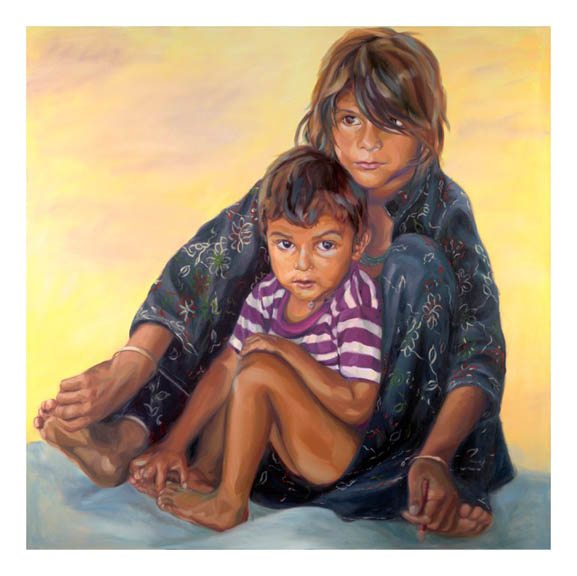
Kailash Satyarthi’s Children: Childhood Reclaimed
The images are searing. Images of children who’ve lost their innocence, their childhood in the harsh world of bonded labor. Their eyes stare back at you without emotion, their lips frozen in a non-smile. This is art but art painted with the colors of true life. Each image by British portraitist Claire Phillips is of a real child, a child slave rescued by Nobel Peace Prize winner Kailash Satyarthi’s organization, Bachpan Bachao Andolan. Meet the artist who journeyed to India to document the lives of these children.
Phillips, born in Hammersmith, England, has a first class degree in fine art painting from Northbrook College in West Sussex. Through large-scale portraiture her work explores the relationship between artist, subject and viewer and the contribution of each to the creation of a work of art. She has exhibited in the UK and her work is in private collections in the UK and Europe.
Kailash Satyarthi and Child Labor
She traveled to India to document the face of child labor in India and she came to Satyarthi’s BBA. “I am witness to the intense discussions that Claire has had with each and every child that she interacted with at Bal Ashram in India,” writes Satyarthi in the forward to the catalog which accompanied the final display of the art, ‘Reclaiming Childhood. ” I can vouch for the efforts that have gone into her marvelous work. These portraits are nothing short of masterpieces that reflect the pain, joy and dreams of children. Commendable and immaculate is the narration.”
Satyarthi adds: “In a civilized society there cannot be any place for those who do not think twice before ruining innocent childhood leaving it bereft of happiness and opportunities. Childhood is sacred. It is divine. Robbing it of this is absolutely sacrilegious and a heinous crime against humanity and God. It is completely unacceptable. Believe you me, the world is not so poor to take away tools and tongs from tiny hands and replace them with books and pencils. Think for a moment what you would do if these were your own children?”
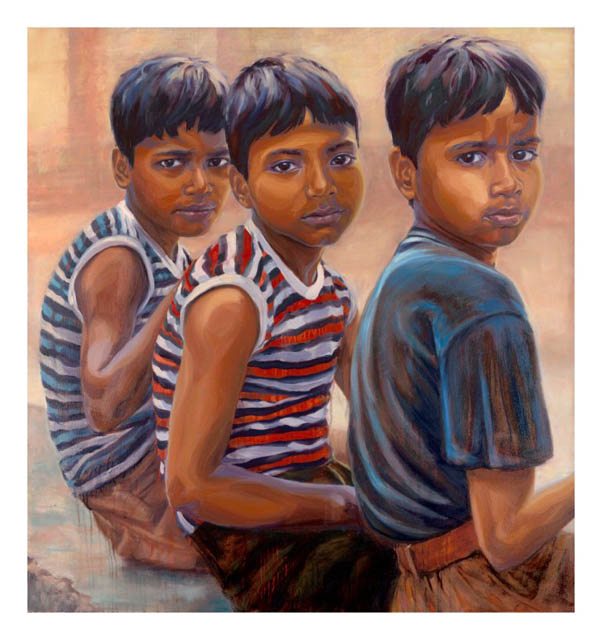
Here Claire Phillips answers questions for Lassi with Lavina about her art and the real life children who made it happen.
Reclaiming Childhood: Questions for Claire Phillips, activist and artist
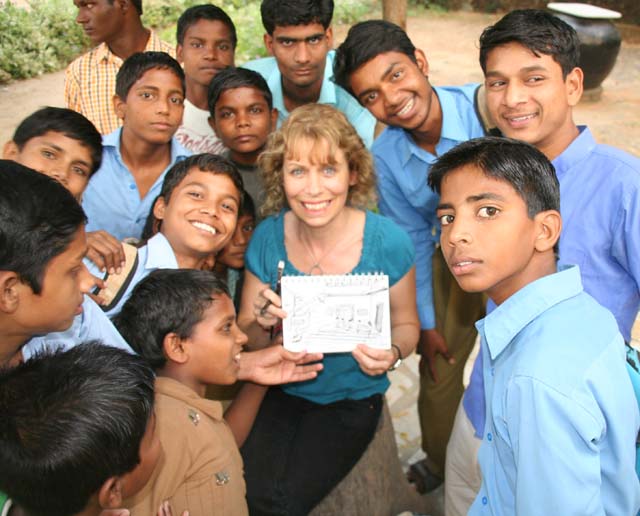
How did you think of painting these children and how did you connect with Bachpan Bachao Andolan?
My work has always been about things that concern me in my life and quite often have a social or political theme. Previous to this work I had worked with a charity called Reprieve who provide free legal representation to people on death row and I did a series of paintings telling the stories of people who had face death row from different perspectives. My aim as an artist is not to campaign but to make a human connection with the person I have met and painted and to encourage debate about the issues behind he painting.
In 2010 I was really moved by an article in the Sunday Times about Bachpan Bachao Andolan (BBA) rescuing children as young as 6 or 7 from terrible child labor conditions. I talked to friends and colleagues and heard many different views such as ‘if they don’t work they’ll starve’, ‘it’s their culture and that’s what they expect in life’, ‘they get dignity from working and helping out financially in the family’, ‘it’s nothing to do with us – we have enough problems of our own’. I realized that I could not impose my Western values on a different culture so I contacted BBA to ask them about it – they invited me out to meet the children and make up my own mind and, of course, I ended up taking many photos, sketching, interviewing children and came back and painted the Reclaiming Childhood Series.
What kind of a difference does an organization like BBA make in the lives of children?
Bachpan Bachao Andolan (BBA) transforms children’s lives and gives them back their freedom, an education and a future. BBA has rescued over 80,000 children from child labor. Many of the rescued children have been working as slaves in terrible conditions for 12-14 hours a day with no pay and very little food. The vast majority are trafficked from very poor states in India. An ‘uncle’ (not necessarily a real uncle) tells the parents that they will take their child and give them a good education and opportunities in life that the parent can’t provide. They say that the child might do a small amount of work and send some money back to help the family. The parents are generally very poor and uneducated and think they are doing the right thing for their child. The children are taken away and the parents never see them again – the promise of education and a better life is all a lie. The children become a very valuable resource for factory owners as they work longer hours for no pay and cannot complain to anyone as they are more or less kept prisoner in the factories.
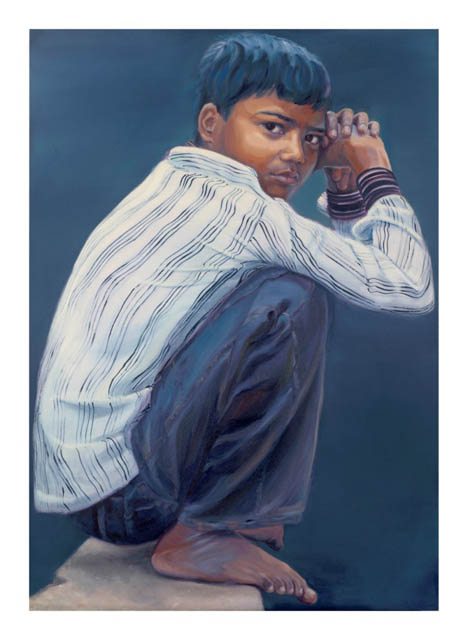
What were your experiences with the children there and what was the most moving incident for you?
BBA’s activists risk their lives every time they rescue children as the factory owners often attack them – two activists have been killed during rescue operations. Kailash and his colleagues have been beaten many times but they still continue rescuing children whenever they can.
When I first went to India I visited Mukti Ashram, the immediate safe home for boys who had just been rescued. I have tried to portray my experience of meeting the children in Mukti Ashram Boys, Kayum and the Three Rescued Boys. Children as young as 8 years old sat around in silence, clearly traumatized and frightened. BBA give them counseling, care, good food, exercise and play and start a basic education while they search for their families. The legal processes are quite rigorous to prevent the factory owners pretending to be parents and coming back to claim them. It took a several days for the boys to trust me enough to talk to me and they were still unnaturally quiet and wary.
The difference made by BBA became most apparent when we visited Bal Ashram, the boys rehabilitation home in Rajasthan. Children go to this home for longer term education if their parents can’t be traced or if they are likely to go back to a similar environment without hope of education. These boys had experienced the trauma of trafficking, slave labor and been rescued to Mukti Ashram but they had received love, care, counseling and education over a longer period of time. These boys were completely different – full of life, energetic, laughing, singing, playing, studying and dancing (Bollywood style!). Some of these boys are so confident that they make speeches all over the world campaigning against child labor – even boys as young as 13 or 14. Many will go on to study at degree level, becoming doctors, lawyers and engineers. Others will learn a trade such as electricians, mechanics etc.
BBA focus as much on the girls as the boys and I met girls rescued from domestic labor who had suffered abuse and sexual exploitation . I also visited a school for little girls who are from the poorest villages who are now protected from the traffickers and given a good education. BBA work hard on prevention as well as rescue.
BBA also travels round the remote villages educating them about the dangers of traffickers and establishing Bal Mitra Grams (Child friendly villages) where they empower the villagers to obtain their rights to a school and fresh water well so that the children are able to go to school. A child friendly village has to have a children’s council to give the children a voice and at least two thirds of the children’s council leaders have to be girls to counteract the traditional gender inequality in the villages. These children will never have to suffer the trauma of trafficking, slave labor or child marriage and access to education gives them confidence and opportunity.
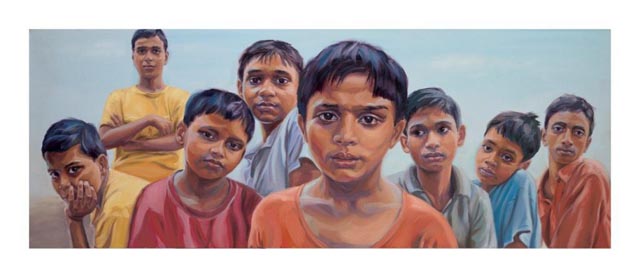
Tell us about your time in India.
The most striking thing about my experience in India was that these children are the same as my children, my neighbor’s children and any wealthy Indian or Westerner’s children – they are all the same. I did drawing workshops with them and they loved them so much. In Mukti Ashram it broke the ice for these traumatized withdrawn little boys and they started to tell me their stories and even smile a bit! It was apparent that these children had never had the opportunity to draw or color before.
Probably the most harrowing incident that we witnessed was parents coming every day to the Ashram weeping and begging for help to find their lost children. Some of these parents had travelled hundreds of miles and we witnessed some parents being reunited with children they hadn’t seen for months or years.
Another very moving time was on our second visit to Mukti Ashram when I asked (through an interpreter) a very tiny, newly rescued boy how old he was. His big brown eyes filled with tears as he whispered that he didn’t know how old he was or where he came from. Some of these children are trafficked at such a young age from remote states that they lose their original language.
Are you very much a child activist and how are you involved with Reclaiming Childhood movement?
Primarily I am a portrait artist and storyteller! I try to portray the children and tell the stories as objectively as I can. My aim is not so much to campaign but to make a human connection between the viewer and the subject and to make the viewer think about their life and the issues affecting them. Each painting has to work on its own as a painting. Having said that, I found it difficult to just let it go having exhibited the paintings, and have become involved in the campaigning side through the End Child Slavery Week in November 2014.
Children and adults all over the world, including the children I met in India, walked a km or signed a petition in support of the 5.5 million child slaves worldwide. This petition is to demand that the abolition of child slavery should be included as a priority on the United Nations post-2015 Development Agenda. I am fortunate also that local schools and community groups invite me in to talk about the work and often raise money or make donations to BBA after hearing of their great work.
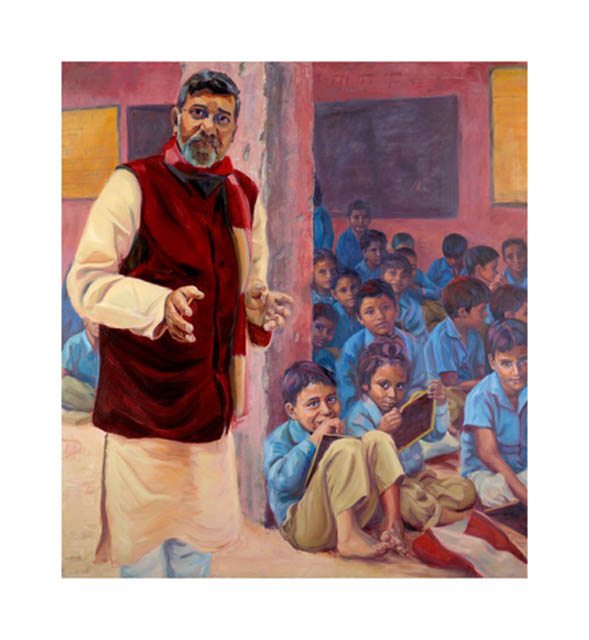
At that time Kailash Satyarthi was not that known to people – what were your impressions and interactions with him?
What a wonderful surprise it was to hear that Kailash had won the Nobel Peace Prize. It was particularly apt that he should share it with Malala as they are both working to give children a better future and an education. He is an incredible man who has risked everything to rescue these children. He is extremely humble and shies away from the limelight unless it helps the children and the movement.
During our trip to India I met with Kailash for breakfast. I knew that I wanted to paint him but was so taken up with his story that I forgot to take many photos! When I got home I realised that the photos were not suitable so I met up with him again when he was in London and took some more. The painting you see is a composite of Kailash in London and the children in the school in Rajasthan!
When the exhibition launched in London Kailash came to the gallery and gave a very eloquent and thought-provoking talk about child labor and the importance of education for all children. We were privileged to share dinner with him in London. We also met Kailash’s wife and son and daughter–in-law in India who are all very involved in his work. His son, Bhuwan, runs the BBA head office and is a trained lawyer advising the government on child labor issues.
I will continue to be involved with BBA in any way I can but mainly through continuing to challenge people to consider the issues through my paintings and through talks. Also any profits made by the exhibition and sales of paintings will be donated to BBA .
What’s next for you in art?
As a professional artist I now have some commissions to do which earn money to help finance the next project! I will spend the near future painting and also continuing to exhibit the Reclaiming Childhood work wherever I can.
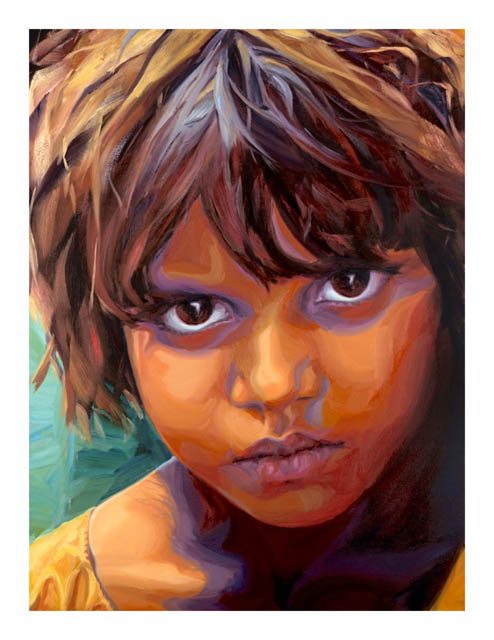
Neha – the Girl who Escaped the Child Traffickers
Neha lives in Manabas, a small village in Rajasthan and one of the poorest in the region – fertile ground for the con-tricks of child traffickers. Before BBA’s involvement, large numbers of children worked and few attended school. BBA’s focus is on educating the villagers about the dangers of ‘uncles’ promising a better life for their children and empowering them to demand from the government their right to school facilities for all their children.
Manabas is now a ‘Bal Mitra Gram’ or ‘Child Friendly’ village. A village is only given this status when all the children attend school and have a voice in the running of the village through a children’s council. Two thirds of the children’s council leaders are girls, challenging the traditional gender inequality in Indian villages. BBA also educate and empower the villagers to improve health care, sanitation and village employment opportunities.
Neha, intrigued by my camera, but shy, peeks out at me, then ducks behind her older brother or mother. As the elders of the village proudly show us around, Neha follows at a distance. I drop back, leaving our guide to talk to the elders, hoping to catch the children at the back. The elders walk on ahead and the young mothers and small children emerge from huts, laughing and gesturing for me to photograph them and their babies. Neha plucks up courage as her brother swings her round. I’m guessing from her grubby yellow smock and tatty brown trousers that she is from one of the poorest families in the village.
Neha’s future is bright now – a childhood free from the threat of trafficking and child marriage; a future where education brings confidence and opportunity.
– Claire Phillips.
For more information on Bachpan Bachao Andolan please visit www.bba.org.in
For more about Claire visit www.clairephillips.com

9 Comments
Via Google +
Reema Roshan
+1’d: Searing portraits of child slaves and of childhood reclaimed by artist Claire Phillips
Via Google +
Pradip Savaliya
+1’d: Searing portraits of child slaves and of childhood reclaimed by artist Claire phillips
Via Google +
Jelureddy Nerella +1’d
via Google +
Zahid Awan +1’d and reshared
Thank you Lavina for this. Such a wonderful person.
Via Google +
Pradip Savaliya
+1’d: Searing portraits of child slaves and of childhood reclaimed by artist Claire Phillips
Thank you Kalpana – Kailash Satyarthi is really someone to be admired for the work he’s done with these children and given them a voice. You can reach Clair Philips at claire@clairephillips.com
This is an amazing post Lavina. I’ve followed Kailash’s work for a long time. Interviewed him once. I love this artist’s idea and the paintings she has done. Is there any way of getting in touch with Claire Phillips?
Via Google +
Jesse Hernandez
+1’d: Searing portraits of child slaves and of childhood reclaimed
Romy. Ezt. +1’d
dongwoon shin +1’d